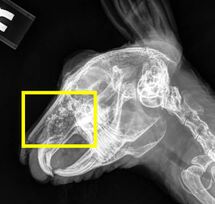Snuffles
Snuffles or rhinitis is not a particular disease but a catch-all term for respiratory infections in a rabbit. The most common bacteria that is the cause of snuffles is Pasteurella, but other common causes include staphylococci and Bordetella.
Symptoms
- Sneezing fits with or without nasal discharge
- Nasal discharge
- Staining of the front paws
- Bleeding from the nose (epistaxis)
- Wheezing and squeaking sounds while eating
Causes

- Aerobic bacteria such as Staphylococcus aureus, Bordetella bronchiseptica, Moraxella catarrhalis, Pseudomonas aeruginosa, Mycobacterium spp., and Pasteurella multocida.[1]
- Anaerobic bacteria such as Fusobacterium nucleatum, Prevotella spp., Peptostreptococcus micros, Actinomyces israelii, and Arcanobacterium haemolyticum.[1]
- Fungus (mycosis) such as Aspergillus spp. - extremely rare
- Dental disease
- Facial trauma
- Foreign bodies such as inhaled vegetable matter. See Hay#Possible dangers of hay for examples.
- Allergic or irritant such as inhaled pollen, moldy bedding, dusty hay or litter, or cigarette smoke
- Cancers (neoplasia) such as squamous cell carcinoma, osteosarcoma, chondrosarcoma, and fibrosarcoma.
Rabbits can also be more prone to snuffles due to stress, concurrent disease or corticosteroid use. Poor husbandry such as dirty molding bedding, ammonia buildup from urine-soaked bedding, dusty cat litter, and cleaning agents can also increase the risk factor of snuffles. Lastly, diets too low in coarse fiber content (long-stemmed hay) can predispose a rabbit to dental disease and consequently snuffles symptoms.[1]
Diagnosis
Veterinarians will diagnose simple minor snuffles with a physical examination based on symptoms. Chronic or more severe snuffles will often require further diagnostics with culture and sensitivity testing of discharge, radiographs, and CT scans to find the root cause of the unending infection.
Treatment
For acute relief, steam therapy (e.g. sitting with rabbit in a steamy bathroom) and humidifiers can help relief congestion. If there is visible mucus outside of the nose, it can be carefully removed with a damp towel or 1cc or baby bulb syringe.
Veterinarians will often first treat an upper respiratory infection (URI) presumptively based on symptoms by prescribing an oral antibiotic. Common choices include enrofloxican, trimethoprim/sulfamethoxazole, doxycycline, marbofloxacin, and azithromycin. In general, if the antibiotic is effective, owners should see a good improvement within 3-5 days.
If the first antibiotic was ineffective, veterinarians may choose to try a different oral antibiotic and evaluate results or proceed with a culture and sensitivity test to figure out the exact strain of bacteria causing the symptoms and an effective antibiotic for it.
If there is still no improvement after choosing an antibiotic with a culture and sensitivity test, further diagnostics such as radiographs and CT scans should be considered to rule out more serious issues such as growths, pus, dental issues, and abscesses causing the chronic infection.
Medication through routes such as penicillin injections and nebulization may also be considered if symptoms are severe.
Allergies may be considered as a diagnosis if all other routes of diagnostics have been inconclusive. However, rabbits with allergies should see marked improvement when prescribed with antihistamines.
Some more resources about treating snuffles in rabbits:
- Ethos Veterinary Health. (2019). Chronic Nasal Discharge in Rabbits: Not Just an Antibiotic Issue
- Sarah Pellett et al. (2016). Bacterial and fungal culture and sensitivity from rabbits presenting with nasal discharge
Experiences
- The Unusual Pet Vets. (2024). Lop rabbit had multiple upper respiratory infections from foreign bodies in her nasal passages (Graphic)
- The Unusual Pet Vets. (2024). 7yo dwarf rabbit had a chronic sneeze and one-sided nasal discharge that did not respond to antibiotics, resulting in a trephination surgery to remove accumulated mineralized material in the sinus (Graphic)
- u/9tails9. (2024). Rabbit with chronic rhinitis due to destroyed nasal passage from prior infections requiring daily nebulization as lifelong treatment
- u/Enigma-AM. (2023). Rabbit with chronic rhinitis due to a mineralized foreign object in one nostril
- The Unusual Pet Vets. (2023). Monty the lop had a grass seed lodged in his nose, causing chronic sneezing (Graphic)
- u/sneaky_dragon. (2023). A 6-year-old Holland Lop struggling to breathe underwent a rhinotomy surgery to clean out purulent material from untreated upper respiratory infections (Graphic)
- Allison Zwingenberger. (2017). Radiographs of a 5-year-old rabbit with respiratory distress and nasal discharge found with a mucinous adenocarcinoma and metastatic disease to the lung upon necropsy (RIP)
Further reading
- Maria Zayas, DVM. (2024). Snuffles in Rabbits
- Texas A&M School of Veterinary Medicine & Biomedical Sciences. (2012). A Case of the Snuffles
- Angela M. Lennox, DVM, Diplomate ABVP (Avian). Respiratory Disease and Pasteurellosis
- Frances Harcourt-Brown. (2009). Cardiorespiratory disease
- Bishops Stortford Vets. Snuffles - the facts
- PetCoach. Snuffles (Pasteurellosis)
- Rabbit Welfare Association and Fund. Rabbit Snuffles
- Dana Krempels. Runny Eyes, Runny Nose. What do They Mean?
See also
References
- ↑ 1.0 1.1 1.2 Barbara L. Oglesbee, Blackwell's Five-Minute Veterinary Consult: Small Mammals, 2e.

